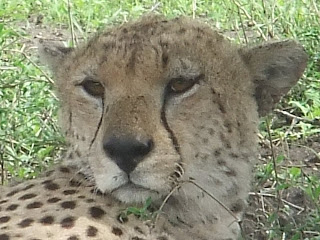Yesterday we went to "Beit el Mtoni", or house at the creek in persian. It is in persian because the first Sultan of Zanaibar was from Persia. He was called Sultan Seyyid Said Bin Sultan and his daughter, Princess Salme, was the princess of Zanzibar. Salme's mother was actually a slave to the Sultan, but Salme was born with all the priviledges of a free child. After going around the ruins of the palace and the persian baths, we went on a donkey ride around the gardens. Salme used to like riding by donkey cart. She also enjoyed taking a trip on a dhow, which we did next, sailing up the coast to Salme's uncle's home which has been restored. We had a coffee ceremoney here, but I didn't really enjoy the coffee. Afterwards, we took a dadala (a small taxi like a matatu) to the spice plantation that was once owned by the second Sultan of Zanzibar (Salme's brother.)
At the spice farm I learned about many different fruits and spices some of them were:
1. Cinnemon which is called the king of spice. It can cure 20 diseases including blood pressure, digestion, headaches, and asthma. You can use the roots, the bark and the leaves.
2. Cardamon is called the queen of spice and can cure 16 different diseases including the hiccups!
3. Cocoa is used to make chocolate
4. Lime, which was my favorite smell, helps prevent colds and headaches.
5. Starfruit really looks like a star shape and it is very high in vitamin C.
6. Kapok cotton comes from the kapok tree. The adolesent trees have spikes on their trunks to stop animals from climbing it. The cotton is used for plaster casts, pillow stuffing and to seal the dowhs at the seams.
7. Lemon grass is very healthy and used to make tea, as well as an scent to keep mosquitoes away.
8. Jackfruit was one of my favorites. It is very big and heavy with lots of single fruitlets like pineapple. I had the chance to eat one and it is very sticky.
9. Ginger grows close to the ground and we only use the roots.
10. Pineapple also grows on the ground in small bushes, with one or two fruits per bush. If you cut off the top of it and plant it, you will get another bush.
At the end of our tour, a boy climbed up the coconut tree using just a short rope around his feet and shimmied up the tree to throw coconuts down for us to drink and eat. He aslo made a top hat and tie for our each of us.
I really enjoyed ths spice tour and I think I will eat more spices and tropical fruits now that I know about them!





















































